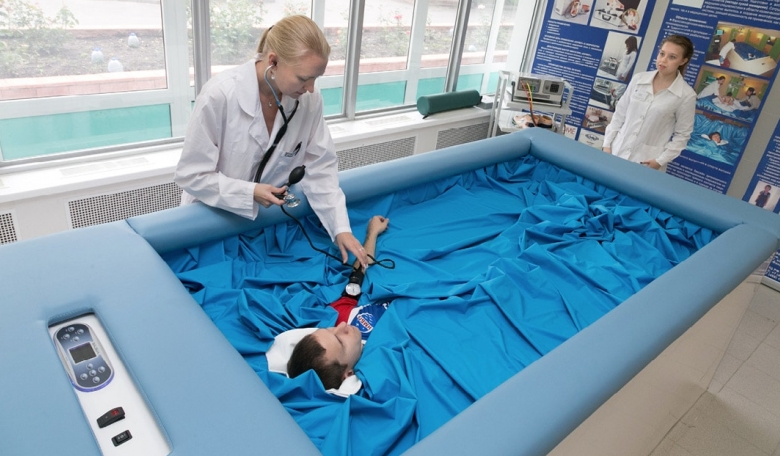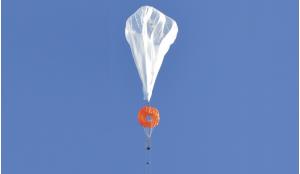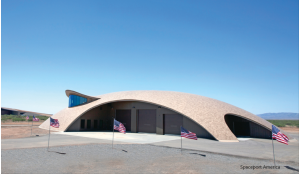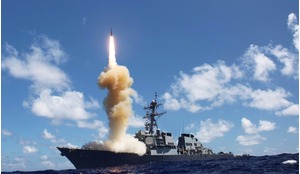The development of space research and the move to applied space exploration have shown that weightlessness causes one’s body to become ‘de-trained’ - that is to lose its ability to properly react to gravity. In order to solve many applied and fundamental issues relating to this problem, scientists have to develop zero gravity simulations.
The most promising simulations for researching physiological effects of hypo-gravity are immersion (into a liquid environment, with a density similar to that of human body tissue) and antiorthostatic hypokinesia. A support-free environment, the removal of localised weight loads, close proximity to the biomechanical conditions of motor function organisation to those present in weightlessness - all of these factors have predetermined that water immersion is practically the only viable simulation model for weightlessness training.
In the early 1960s, researchers began exploring the physiological effects of immersion in order to determine the possibility of using it to imitate the effects of weightlessness on land. It was determined that immersion accurately simulated the motor, cardiovascular and other physiological changes that a human body experiences in weightlessness. The possibility of using immersion as a fully-fledged simulation were limited only by lack of comfort and the possible danger of prolonged skin contact with a liquid environment.
Early studies
Dry immersion involves immersing the subject in thermoneutral water covered with an elastic waterproof fabric
In the early 1970s, two scientists at Moscow’s Institute of Biomedical Problems - K.B. Shulzhenko and I.F. Will-Williams - developed a method for prolonged use of immersion research, based on the principle of ‘dry’ immersion, which uses a specially-made waterproof and high-elasticity fabric.
When using this method, the test subject, dressed in a t-shirt and swim trunks, is asked to lie on the hydro-isolating fabric and is then submerged into a liquid environment up to the neck. The surface area of the fabric is significantly larger than the surface area of the water. At the same time, the folds of the hydro-isolating material close in on the centre of the tester’s body, freely enveloping him on all sides.
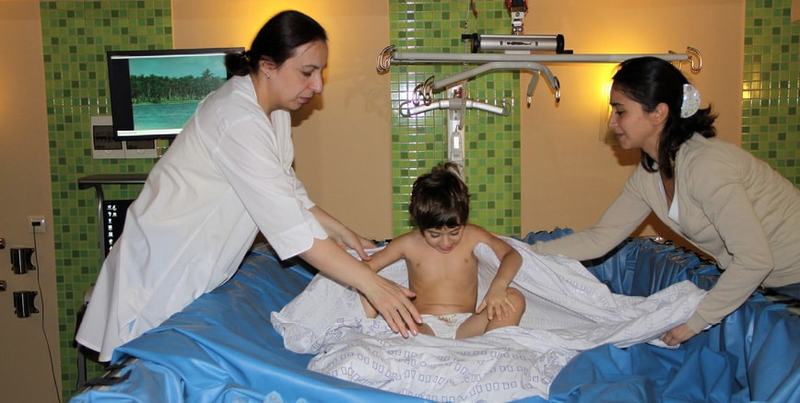 Using the dry immersion method in medicine - short immersion sessions at the clinic help temporarily to relieve muscle hypersthenia in children with cerebral palsy.
Using the dry immersion method in medicine - short immersion sessions at the clinic help temporarily to relieve muscle hypersthenia in children with cerebral palsy.
No cradling supports are used for the tester’s body in the immersive environment. The high-elasticity of the fabric artificially increases the liquid’s density, practically creating the conditions of zero buoyancy. From its inception, this model became the main type of simulation used in Russia for the study of acute effects of weightlessness for periods of five to seven days, equal to short spaceflights.
The temperature of the water in the tub is constant at 33C. The daily schedule in immersion is regulated by set time intervals, that are chosen for examinations, preventive activities (if such are required), eating and sanitary/hygienic procedures. The daily schedule is maximally close to the schedule on the ISS, and includes eight hours of sleep, three meals per day, a medical control programme and experimental research. Subjects are removed by special lift from the tub once daily, for 15-20 minutes for sanitary/hygienic procedures. Therefore, this form of immersion combines the three effects of spaceflight: hypodynamia, the removal of support loads and the vertical vascular gradient.
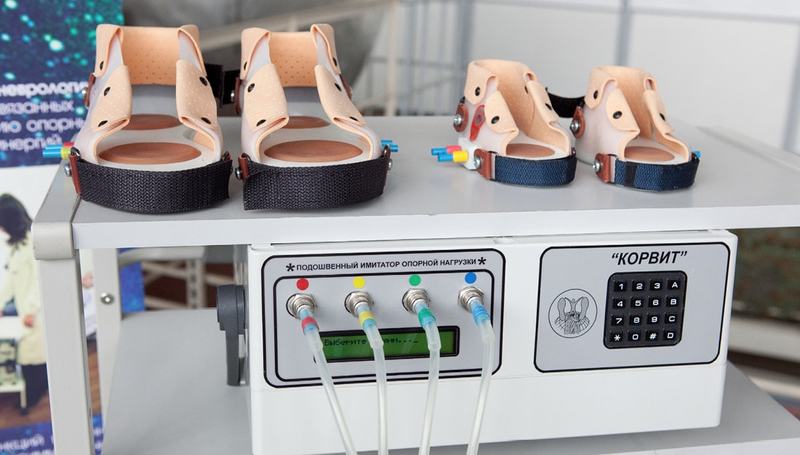 KORVIT medical equipment for mechanical stimulation of feet in natural locomotion regimen.
KORVIT medical equipment for mechanical stimulation of feet in natural locomotion regimen.
In 1974, Shulzhenko and Will-Williams conducted a record-breaking 56-day immersion experiment with the help of two volunteer testers. The experiment successfully and convincingly showed the usability and safety of such methods for simulating lengthy weightlessness.
Spaceflight similarities
Immersion research has opened a new chapter in movement physiology, which could be called the gravitational physiology of movement
During the first years of using this simulation model, research concentrated mostly on describing the effects of weightlessness on the human body. First and foremost, the studies looked at vital body functions - the cardiovascular system and metabolic indicators. This research showed the similarity between effects produced by immersion and the effects of spaceflight in type, speed of development and intensity.
Based on subjective opinion, being immersed first feels like a comfortable and pleasant state of relaxation. Later on, however, some test subjects reported that their head felt heavy, and they had slight nasal congestion. During the first two days, most testers complain of varying degrees of back pain; all of these symptoms disappear by day two or three. In rare cases, sleep disorders, loss of appetite and digestive problems have been observed.
From the very beginning of human spaceflight, immersion was used as a quick and convenient simulation model for evaluating the effectiveness of the developed physical preventative care in weightlessness.
This research was carried out at the State Science and Research Testing Institute for Aviation and Space Medicine in Russia by A.M. Genin, I.D. Pestov, V.I. Stepantsov, A.V. Eremin and other specialists who originally worked on medical supply and equipment projects. Later on, it was conducted by the Institute of Biomedical Problems.
In experiments with 18-hour water immersion, some of the tested methods included: occlusive femoral sleeves; the decrease of compensatory counter pressure of the immersive environment on the lower part of the body; periodic increase of intrathoracic pressure up to 200 mm Hg due to breathing resistance at exhalation; breathing under conditions of excess pressure, a complex of pharmacological stimulants, and anti-gravity suit.
Areas of research
However, the impossibility of providing long-term exposure to water immersion limited the variety of subjects that could be researched. The dry immersion method, which opened up the possibility of longer exposure, provided the possibility of entirely new research directions.
A number of preventative methods were tested using immersion simulations - such as the short radius centrifuge, various electro-stimulators, mechanical stimulation of the foot support zones, ‘Penguin’ axial loading suit, etc.
Beginning in the mid-1970s, the dry immersion model became central to research aimed at exploring how microgravity affects the motor system, which is considered the most gravitationally dependent system of the human body.
Immersion research has opened a new chapter in movement physiology, which could be called the gravitational physiology of movement. The orderly study of all parts and functions of the locomotor system, on the systemic and the cellular level, showed that gravitation is such an innate part of the locomotor system, that it is impossible to find any aspect of the system that does not suffer change after being subjected to weightlessness.
The ‘dry’ immersion model became central to research aimed at exploring how microgravity affects the motor system
First and foremost, weightlessness affects the muscular system. Changes to the muscular system, in particular the decrease in speed and strength, were known from the earliest flights, but these changes were only quantified and their development over time was recorded when immersion simulation became possible.
Comparing results of a seven-day immersion with those obtained during a seven-day spaceflight showed that physical changes that a body underwent were identical. Immersion work has allowed researchers to not only describe these phenomena but to also begin to understand the nature of early decrease in muscle quality, which, of course, could not have been related to atrophy, which would require a much longer period of time to occur.
Lately, the dry immersion simulation has become more and more popular. More and more researchers, both Russian and foreign, participate in the Institute of Biomedical Problems immersion experiments - DLR (Germany), Université d’Angers and Université de Cannes (France), and others. The study of other body functions and systems confirmed theories that lack of support has an effect on almost all of the body’s systems.
Medical benefits
The ‘dry’ immersion method has also been of great clinical use. In the 1980s it was used to treat oedemas, especially oedemas of varying etymology that were hard to cure (those stemming from cardiovascular problems, burns, liver cirrhosis and kidney impairment). Research studies on the use of dry immersion for hypertensive crises cases appeared in the 1990s.
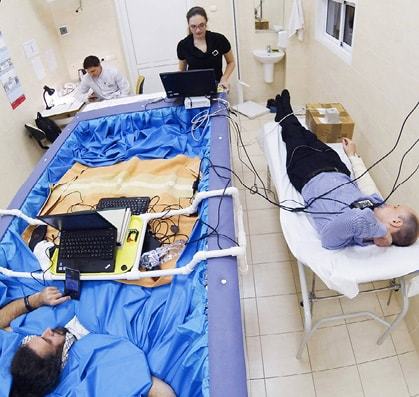
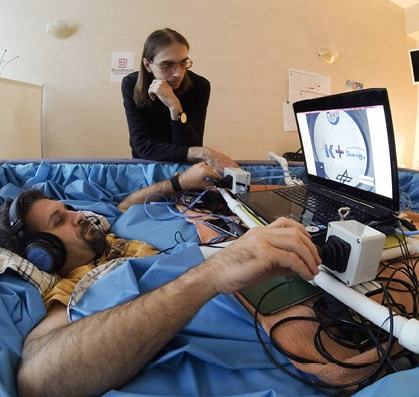
The dry immersion method is widely used in paediatric care as part of a set of rehabilitation techniques for premature babies that’s aimed at normalising hemodynamics and preventing brain oedemas. Immersion is also used in rehabilitation treatments for children with central nervous system problems, such as perinatal encephalopathy. As an effective method for lowering muscle hypertonia and hyperactivity, as well as reflex alleviation, this method is widely used in cases of children’s cerebral palsy.
Immersion is also used in rehabilitation treatments for children with central nervous system problems
Joint Russian-Austrian experiments have shown dry immersion as a great diagnostic tool for early detection of neurological problems that are otherwise well compensated for or hidden under normal conditions. Dry immersion has also been shown effective in helping athletes recover after difficult training sessions.
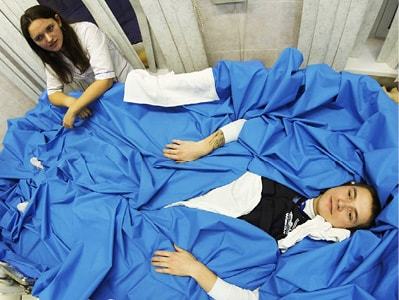
Inessa B. Kozlovskaya is head of the department of sensory-motor physiology and countermeasures at the Institute of Biomedical Problems of the Russian Academy of Sciences (RAS), founder of the School of Gravitational Physiology of Movement, MD, PhD, professor, corresponding member of the Russian Academy of Sciences, IAA academician, Honoured Scientist of Russia, winner of State Prize of the Russian Federation and Government of the Russian Federation Award.
Elena S. Tomilovskaya is the head of the laboratory of gravitational physiology of sensory-motor system at the Institute of Biomedical Problems of the Russian Academy of Sciences (RAS), PhD and IAA corresponding member.





